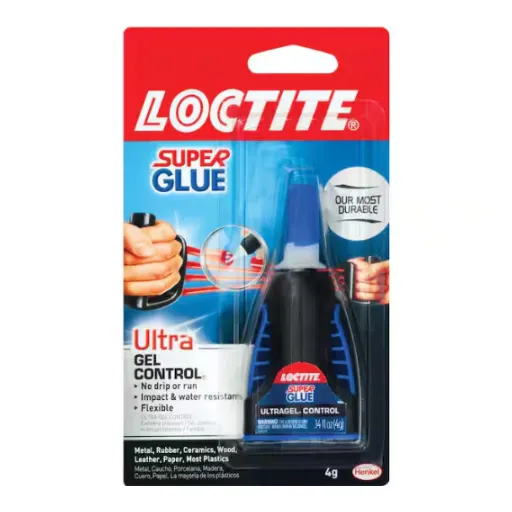The selection of the proper adhesive might be the decisive factor when it comes to fixing, fastening, or securing materials. Among the adhesives, two that are very commonly used and continue to cause discussions are threadlocker and super glue. Their effectiveness is high in both cases, and yet they have diverse uses and are very good in particular applications. What is going to be your criteria for distinguishing the better one for your project? This detailed guide will reveal the differences, strengths, and best use cases of both threadlocker and super glue, henceforth giving you the insights needed to make a non-deceiving choice. In case you’re working on a DIY project or a critical mechanical repair issue, this article will certainly direct you to the adhesive that performs according to your requirements.
Understanding Super Glue and Loctite
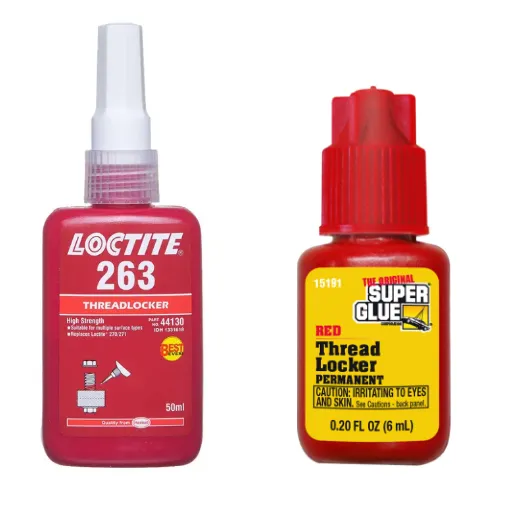
Chemical Composition of Super Glue
Super glue, also known as cyanoacrylate adhesive, is a fast-acting bonding agent valued for its rapid curing time and strong adhesion properties. The principal ingredient in super glue is a cyanoacrylate resin, which undergoes polymerization when exposed to trace amounts of moisture typically found in the air or on the bonding surfaces. This reaction creates strong chemical bonds in a very short period, making super glue ideal for quick fixes and precise applications.
The adhesive works best on non-porous materials like metal, plastic, and glass, where its strong interfacial bonding can be fully utilized. It forms a rigid bond upon curing, which makes it less ideal for applications requiring flexibility or exposure to significant stresses. Super glue is also sensitive to extreme temperatures and prolonged exposure to water, which may weaken the bond over time, limiting its suitability for certain outdoor or high-temperature environments.
Despite its versatile applications, it is important to understand the limitations of super glue’s chemical composition. Overuse or incorrect application on porous materials, such as wood or fabrics, may lead to weak bonds as it relies on surface-level adhesion. Additionally, the adhesive is not suitable for large gaps or structural repairs requiring extensive load-bearing, as it lacks the flexibility or thickness to fill significant voids. By understanding its chemical foundation and proper use cases, super glue can be a powerful tool in various repairs, crafts, and assembly projects.
Chemical Composition of Loctite
The super glue from Loctite is mainly made up of cyanoacrylate, which is the primary active compound of the product. Cyanoacrylate is the one responsible for the quick adhesion and its strong and lasting bond creation by rapid polymerization. The latter is due to the presence of moisture. This characteristic is the very reason why the product’s fast curing capability has been considered one of its most important attributes. Moreover, it is during this process that the synergy between the four materials—metal, plastic, ceramic, and rubber—is achieved, as they get bonded almost instantly.
Cyanoacrylate is most likely accompanied by stabilizers and thickeners which are the other ingredients usually found in these types of adhesives. Stabilizers are added to control the cyanoacrylate’s polymerization rate so that it does not happen too soon, whereas thickeners are added to alter the glue’s thickness or viscosity according to its different uses. Also, the formulation may include modifiers to change some glue characteristics such as flexibility, impact resistance, or heat tolerance.
User-friendliness and safety are the main factors taken into consideration when manufacturing some of the variants containing compounds that diminish fumes or irritation. The need for better performance and solutions to particular problems is the reason behind the presence of these extra ingredients, yet the primary bonding strength still depends on cyanoacrylate. Employing good handling practices along with observing safety regulations is vital to guarantee that you will be able to enjoy the benefits of the product to the fullest while at the same time avoiding any potential risks.
Intended Applications of Super Glue vs Loctite
Both super glue and Loctite are very strong adhesives but their intended applications are different based on the properties and formulation of the latter. Super glue is primarily for quick general-purpose repairs on small areas. Plastics, metal, wood, and ceramics are some of the materials that it adheres to quite well making super glue the ideal choice for small household repairs, model making, and other light jobs. One of the main reasons for the popularity of that application is the fast curing time and ease of handling the product.
Contrarily Loctite products are more often than not aimed at very specific and expert purposes. They consist of specialty formulations for industrial applications that include the securing of machine parts, the gluing of porous or non-porous materials as well as the providing of resistance to extreme conditions such as high temperature and vibrations. Thus, these adhesives are widely accepted in automotive, construction, and engineering where accuracy and strength i.e. properties are of utmost importance.
In the end, the choice between the two will depend on the size and requirements of the job. Super glue is ideal for fast and small jobs while Loctite gives a bigger variety of options that are specifically made for cases that need long-lasting and reliable performance. Both adhesives are very powerful but using the right adhesive will give the best possible outcome for the application that it was intended for.
Comparative Analysis of Adhesive Properties
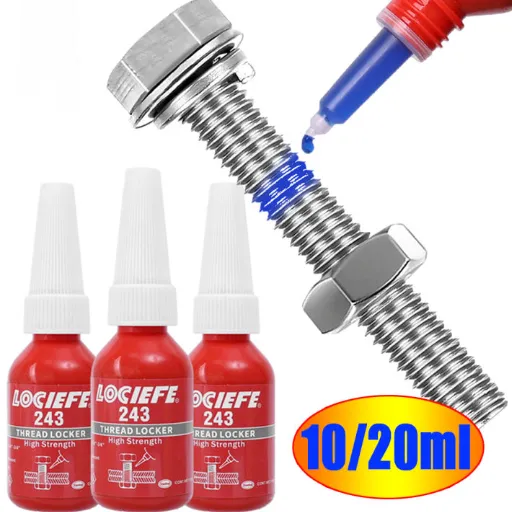
Cure Times: Super Glue vs Threadlocker
In the comparison of super glue and threadlock, one cannot help but notice that these two adhesives are aimed at completely different markets and that their curing speed is very much in line with their intended use. Super glue, often called cyanoacrylate, is recognized as having an extremely rapid curing time. Normally, super glue takes about 10 to 30 seconds to set and around 24 hours for full cure. This quick bonding process makes it suitable for very fast repairs, home projects, and activities where downtime is to be kept as minimal as possible.
On the contrary, threadlockers offer a more reasonably paced curing process. Depending on the specific type and formulation (for instance, the removable, permanent, or medium-strength ones), threadlockers typically go through a curing process lasting anywhere between 10 and 30 minutes until they progress into the final stage of curing which is about 24 hours. Some high-strength threadlockers may take as long as 72 hours to attain maximum strength. Other factors such as heat and the type of substrate can also affect the curing process. Threadlockers are particularly effective on threaded fasteners and their curing takes place in a condition devoid of air (anaerobic) with the presence of metal ions thus guaranteeing a strong and vibration-resistant bond.
Important Note: For better understanding, it is necessary to point out environmental factors such as temperature and humidity that also have an impact on curing times of both adhesives. For instance, super glue usually gets cured faster when the humidity level is high whereas threadlocker takes its time in performing optimally within its specified temperature ranges which are usually between 50°F to 150°F (10°C to 65°C).
Choosing the right adhesive based on the curing time and application leads to efficiency and dependability both in the short term and in the long-term project.
Ultimate Bond Strength of Super Glue and Loctite
Envisioning the ultimate bond strength of super glue and Loctite is exhaustive without reference to the specific formulations that each brand has dedicated to that different type of material and application. Super glue, otherwise known as cyanoacrylate, is recognized as the strongest among adhesives when applied to non-porous surfaces like metal, plastic, and glass. Under ideal circumstances, many products containing super glue can reach shear strengths of around 1,000 to 4,000 psi while the actual strength depends on the material being bonded.
Conversely, Loctite offers a wide range of glue-like products that fall into different categories, from threadlocking to bonding. For instance, Loctite’s 271 threadlocker which is considered to be one of the most powerful, can resist shear forces ranging from 3,000 to 5,000 psi thus giving strong support to the automotive and industrial applications. Moreover, the company’s epoxy glues such as Loctite Epoxy Weld are capable of holding metals together with a tensile strength of 3,300 psi which is ideal for situations where the bonding of metal surfaces is critical.
Both super glues and Loctite have very impressive adhesive properties but their performance will largely depend on the material type, method of application, and the surroundings. Super glue is generally suitable for smaller, finer jobs while Loctite is the best choice in scenarios of heavy-duty or high-stress as it will ensure delivery of superior performance even in the case of industrial and long-term projects.
Super Glue and Threadlockers Both Offer Different Degrees of Removability
There is a huge difference in removability of super glue and thread lock adhesives based on the adhesive types and the removal methods applied. Super glue, which mainly consists of cyanoacrylate, creates a very strong bond with most of the surfaces and does so very quickly. Though, acetone usually works in dissolving the bond. For instance, the application of acetone on cotton and doing soaking can be used for loosening of the glue to an extent that it is easily detachable. In the case of non-porous surfaces, super glue is sometimes removed by careful scraping with the use of a blade, but this may cause the surface to be damaged.
In contrast, thread locker products such as those made by Loctite are meant to be either semi-permanent or permanent adhesives, especially in threaded fasteners. The removal process for Loctite Blue (medium strength) will often entail the application of a tool to actually break the bond. If they are removables, the high-strength threadlockers (e.g., Loctite Red) usually have to subjected to heat as temperatures exceeding 500°F (260°C) are necessary to loosen the bond to the extent that the removal process can be started. This procedure entails using a heat gun or blow torch to deliver even heat to the area of bonding while the precautions are being taken to avoid injury or damage.
Recent info reveals that the outcome of various removal techniques is strongly linked to the adhesive type and surface material. Manufacturer specifications suggest the use of medium-strength threadlockers like Loctite 243 in removable applications where tools are accessible. On the other hand, stronger grades such as Loctite 271 are suggested for those bolts that are unlikely to require removal due to their very high resistance. Also, there are studies that indicate super glue’s adhesion strength is affected by humidity and surface condition during application, where drier conditions are more conducive to easy removal.
Pros and Cons of Using Super Glue Instead of Loctite
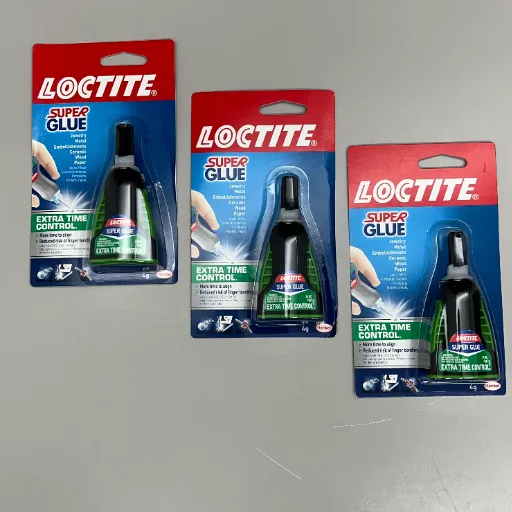
Cost and Accessibility
In general, super glue is priced lower and it is more accessible than specialized threadlockers such as Loctite. Almost every hardware or general store has it for sale, sometimes at a much lower price than that of threadlockers. This situation encourages the use of super glue in small or casual applications that are particularly sensitive to cost as a deciding factor.
Nonetheless, super glue’s cheapness and accessibility do not always make it a suitable candidate for fastening purposes. The glue’s properties might not be able to withstand conditions caused by vibration, high heat or great mechanical stress, this is due to its relatively weak and non-durable adhesion. On the other hand, even though specialized threadlockers, being more expensive and at times difficult to find, are such applications and more consistent results they are the ones that deliver.
The decision in the end is about the super glue or the threadlockers depending on the use for which they are intended. Super glue may simply be enough for light-duty or temporary bonding if cost and convenience are your primary considerations. However, you need to invest in purpose-designed threadlockers to avoid the risk of failures and the consequent cost in the long run for critical assemblies or industrial applications.
Material Compatibility and Long-term Durability
Material compatibility is one of the most important considerations when it comes to choosing between super glue and threadlockers as bonding solutions. Super glue, a cyanoacrylate adhesive, bonds well to a number of non-porous materials, such as metals, plastics, ceramics, and glass, among others. Even so, some surfaces like polyethylene or polypropylene may not accept the adhesive unless special surface treatments are done. Threadlockers, on the other hand, which are specifically designed for fasteners, have excellent performance on metal parts but are not as effective on plastic threads unless designated for this purpose.
Threadlockers are often the more expensive option for long-term durability. The threaded fasteners of the adhesive cure into a strong bond that produces very powerful resistance to vibrations, shocks, and temperature changes. Super glue, in contrast, may become less effective if it is exposed to the forces of nature, and in time, it will become less strong if it is continuously stressed, heated, or wetted. All of this makes threadlockers win the race of options where longevity and changing attributes are of primary concern.
In the end, the decision comes down to the details of your particular project. Should the application entail temporary assemblies or non-load-bearing parts, superglue will likely do. Threadlockers, which are considerably more durable and dependable, are the only option for permanent high-stress installations that face environmental challenges. A Material specifications and the environmental conditions should be reviewed carefully before making a choice.
Resistance to Environmental Factors
Typically, threadlockers exhibit a greater tolerance to environmental factors than super glue. These adhesives are, in fact, made to resist temperature variations, moisture, and vibration, thus being dependable even in extreme conditions. Hence, these compounds are the best alternative for bonding applications in difficult environments, such as the manufacturing of machinery or the construction of outdoor structures, among others.
The main attribute of super glue is its strong initial bond; however, it is more prone to such environmental factors as heat and prolonged moisture exposure. After certain time, these factors might reduce the bond and thus make it less effective in demanding conditions. Therefore, super glue is more appropriate for indoor use or where little environmental stress is present.
When considering which one to use, first assess the particular environmental challenges of the application. For long-term bonding strength under stresses, threadlockers are the right choice. However, if the bond is going to be of short duration only with minimal exposure to atmospheric factors, super glue may be adequate. Your material requirements and the bond’s environmental conditions must always be taken into account for making your choice.
Use Cases for Super Glue and Loctite
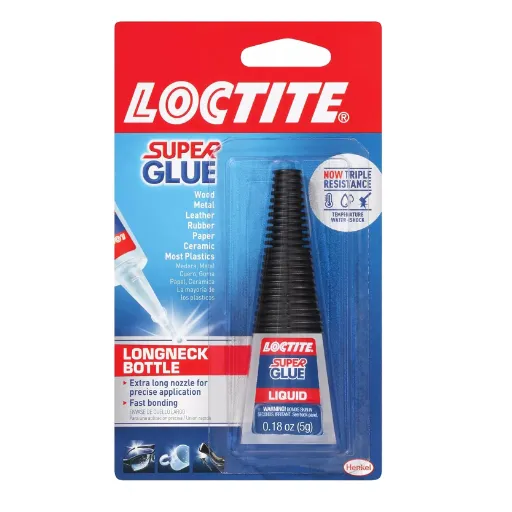
Automotive Repairs: Choosing the Right Adhesive
Adhesives play a crucial role in the automotive industry as they provide effective solutions for bonding and sealing as well as for securing different parts. When selecting between super glue and Loctite threadlockers, it is very important to have a clear understanding of the particular requirements for each repair.
Super glue, cyanoacrylate by its chemical name, is the product for those who need quick and very precise repairs. It works best with small plastic parts, trim pieces, or very minor interior work where the bond isn’t subjected to much stress. For instance, repairing a cracked plastic dashboard component can be easily managed with super glue. On the other hand, super glue should not be used in the situations where it is exposed to very high temperatures or extreme vibrations, as those conditions are common in car maintenance.
In contrast, Loctite threadlocker, like Loctite Blue 242 or Red 271, dominates the market where the adhesion must be strong enough to counteract vibrations and still be very secure. It is often used for locking and sealing bolts, nuts, and fasteners in engines, suspensions, and other high-stress areas. The technical data sheets of Loctite specify that Loctite Red 271 gives a very strong bond that can stand the temperature of 300°F (150°C), hence it is used in heavy-duty applications like axle bolts or flywheel assemblies. Conversely, Loctite Blue 242, a medium-strength adhesive, can be used for those components that may necessitate disassembly afterward, such as alternator brackets or battery terminals.
Using the correct adhesive for car repairs not only saves time but also guarantees that the repaired part will last longer. It is very important to take into account the material type, exposure to environmental factors like heat and vibrations, and whether disassembly may be required in the future. Manufacturer’s specifications and data sheets should always be consulted to achieve the best performance and to maintain safety.
Household Fixes: When to Use Super Glue Instead
Super glue (cyanoacrylate adhesive) is one of the most versatile solutions for household repairs because of its quickly setting nature and strong bonding. It is particularly good for fixing small, non-porous surfaces like ceramic, metal, plastic, and rubber. For example, you can reattach the edges of a broken ceramic piece, fix a plastic item, and even do repairs on small cracks in metal appliances.
Nevertheless, super glue does not work with all materials or in all cases. Just to mention a few, it has no use with porous surfaces that are able to absorb the glue like fabrics and woods; this hence leads to losing the adhesive’s grip altogether. Furthermore, repeated strain, extreme temperatures, or moisture can also contribute to bond entrapment through weakening over time. In fact, recent findings from research want to suggest that epoxy adhesives or other specialty glues could be a better cure for such situations.
Whenever you decide to use super glue, make certain that the surfaces are spotlessly clean and dry and have no trace of grease on them, this is to achieve the best results. To be on the safe side, always refer to product labels for the intended uses since there are some formulations specifically for certain applications—like glass bonding or heat resistance. Always be careful when dealing with super glue in order not to get it on your skin or damage delicate materials. When applied the right way, super glue still remains a must-have in your household repair kit.
Electronics: Super Glue vs Loctite for Circuit Boards
One of the critical factors in delicate electronics handling like circuit boards is the selection of the right adhesive. Circuit and super glue (cyanoacrylate adhesive) and Loctite (a brand that provides various adhesives including threadlockers and super glue options) are top picks among home-use tools, but they have different uses and limitations, especially in the field of electronics assembly and repair.
Super Glue for Circuit Boards
The super glue is the one with quick setting and a strong joint, which is also very handy for making a temporary fix very quickly. On the other hand, the super glue has serious disadvantages when it comes to circuit boards. The first one is that super glue, over time, loses its flexibility and this may cause cracks or failure under vibration or temperature changes. Moreover, regular super glue is not made for insulation and may not be good for high-voltage or high-temperature applications. If the application goes wrong, it might penetrate connections and cause shorts or degraded performance.
Loctite for Circuit Boards
Loctite has special bonds such as Loctite 401 and Loctite AA 330, which are very tough and can be used on various materials. Different Loctite mixtures deliver great electrical insulation and heat resistance properties which make them more appropriate than others for circuit boards. The other thing is that Loctite is composed of materials that can withstand vibrations and still give out the same performance after a long time, which is really significant in electronics.
Data and Insights
It has been found from online resources that for circuit board repairs or a similar situation where adhesive is required, epoxy-based adhesives or silicone adhesives are often preferred over traditional cyanoacrylates because of their flexibility and thermal stability. In the competition of super glue and Loctite, the strength data conveys that adhesives such as Loctite 401 provide tensile shear strength in excess of 20 N/mm² whereas the standard super glues might not be able to deliver the needed structural integrity in case of demanding applications. In addition, the Loctite products are very likely to comply with the industrial electronics standards; thus, giving a safer and more reliable option.
Recommendation
Super glue can be considered as a quick fix in non-critical areas, whereas, Loctite’s diverse advanced adhesives—particularly those designed for electronics—are the ones to rely on for long-term dependability and compatibility with circuit board materials. Be very careful about the particular demands of your project; including heat resistance, vibration tolerance, and electrical insulation properties, when choosing an adhesive.
Safety Precautions When Using Super Glue and Loctite
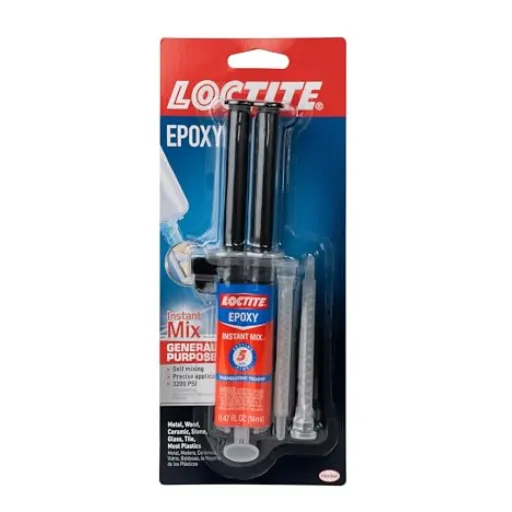
Proper Ventilation and Protective Gear
Correct ventilation and protective gear are extremely important when working with super glue or similar types of adhesives, like Loctite. The majority of adhesives emitVOCsm during the process of application, which might lead to irritation of the respiratory system or even health risks if a person is exposed for a long time. Working in a well-ventilated area, preferably with an open window, exhaust fan, or fresh air coming in, is the best way to reduce these risks. For closed spaces, the use of a fume hood along with a local ventilation system might widely help in lowering the level of airborne chemicals.
Safety gear is of the same value as being used to prevent direct contact with adhesives. Use of nitrile gloves can be a barrier between you and the adhesive, and thus no irritation or accidental bonding will occur since nitrile gloves are resistant to the majority of the chemicals present in adhesives. In the same way, safety glasses or goggles can provide a barrier for your eyes from potential splashes. As per the OSHA guidelines, workers utilizing adhesives should also think about using respirators with organic vapor cartridges when there is no proper ventilation. These are just a few of the precautions that you can take to help create and maintain a safer and healthier working environment especially for long or large-scale projects.
Safe Storage Practices for Adhesives
The proper storage of adhesives is very important as it helps to maintain their effectiveness and the safety of the workplace or home. Adhesives should be stored in a cool and dry place always and direct sunlight and heat sources should be avoided. Extreme temperatures can change their composition and this may lead to the loss of their bonding properties or make them very dangerous. The best place for adhesives is well-ventilated areas so that no harmful vapors will be accumulated.
When it comes to storing adhesives ensure that the containers are tightly sealed after each use to discourage air exposure and evaporation. Besides, the labeling of the containers with the contents and expiry date should be done clearly and legibly, specifically for safety usage. Furthermore, storing adhesives in their original packaging is the best practice, as the containers are made just for that, to keep the product’s integrity intact and to prevent leaks or spills.
Most importantly do not allow children and pets to get access to adhesives at any time. Also, when it comes to adhesives that are flammable ensure that they are stored according to local fire safety regulations, for example, by keeping them in fire-resistant cabinets if required. These precautions will not only help to keep adhesive products for long but also to reduce considerably the risk of accidents and thus a safe environment for all.
First Aid Measures for Adhesive Exposure
In case the skin comes in direct contact with the adhesive, the area should be immediately washed with warm, soapy water. It is advisable to use gentler soaps and avoid any kind of scrubbing which could lead to further irritation of the skin. In the case of stubborn adhesive, gentle oil-based solutions like vegetable oil can assist in loosening the adhesive. Medical attention should be required if there is still redness, swelling, or pain after some time.
For adhesives that have contacted the eyes, they should be flushed with clean, lukewarm water for at least fifteen minutes. While rinsing, keep the eyelid open to make sure that the cleaning is thorough. Do not rub the eyes as this may lead to further irritation or even damage. Once rinsed, a healthcare provider or an eye doctor should be called, especially if there are any changes in vision or discomfort continues.
In case the fumes from the adhesive are inhaled accidentally, move to a place with fresh air as quickly as possible. Take deep, slow breaths to assist in clearing the lungs. If symptoms such as dizziness, headaches, or shortness of breath appear, seek medical advice without delay. In the case of adhesive ingestion, whether intentional or accidental, do not induce vomiting unless a healthcare provider has instructed so. Instead, rinse the mouth very well with water and get medical help immediately. Always try to give the product label information or other relevant information to the emergency personnel, if possible.
Frequently Asked Questions (FAQ)
Q: Can I use super glue instead of Loctite for car parts?
A: Yes, instead of Loctite, you may use super glue for small repair works on car parts. But super glue has not the ability to endure heavy vibration like Loctite. For applications needing permanence, Loctite is often a go-to because it keeps bolts from becoming loose.
Q: What is the difference between blue and red Loctite?
A: Blue Loctite marks the level of strength that can be removed with hand tools as well. Red Loctite has a stronger bond and is for permanent threads. In case you want a quick bonding solution, super glue is the best option for non-porous surfaces, but it might not provide the same strength as Loctite.
Q: Does super glue work for bonding bolts and screws?
A: Super glue will definitely bond bolts and screws, though it is not the best choice in high-stress applications. Vibration or torque at the joint will then make it necessary to use Loctite or the like as a threadlocker so that the fastener does not loosen with time.
Q: Can I use Gorilla Glue instead of Loctite?
A: Gorilla Glue, while a very strong adhesive, is not intended for threadlocking the way Loctite is. If you want to go for a project that needs resistance to water and a permanent bond, then Loctite is the one. Super glue can be used for the not-so-strong repairs, but it might not last as long.
Q: How do I apply super glue for the best results?
A: If you want to get the best bond with super glue, the first thing that you need to do is clean the surfaces that you are going to bond. Take one surface and put a tiny bit of super glue gel on it, and then push the two pieces together. The absence of air will start a chemical reaction called polymerization which produces a strong bond.
Q: Is super glue better than Loctite for certain applications?
A: Super glue has different functions than Loctite. It is most useful for quick repairs on non-porous materials, while threaded applications that require secure holds are meant for Loctite. For projects needing torque tolerance, Loctite is the adhesive of choice.
Q: What should I do if I need to undo the fastener?
A: If you have used super glue to attach a fastener and you want to remove it, you are likely to face some difficulty because super glue makes a very strong bond. On the other hand, Loctite can be removed using the correct tools like a torque wrench thus making disassembling easier when needed.
Q: Are there any risks with the improper use of super glue?
A: Absolutely, improper use of super glue can make the bond fail in high-stress applications. With that, it is very important to select the appropriate glue. One such example is using super glue instead of Loctite on threaded connections, which might not hold the required torque and could fail over time.
Q: Can nail polish be used instead of Loctite?
A: Nail polish can be a short-term solution to securing bolts and screws, but it will just be less effective than Loctite. In case of a critical requirement for a strong and permanent bond, it is advisable to apply an adhesive meant for such like Loctite or similar threadlocker.
References
- Super Glue vs Loctite: Which Adhesive Reigns Supreme? – Discusses why super glue is generally not recommended for threaded applications compared to Loctite.
- Loctite vs Other Brands: Which Glue Holds Best? – Compares Loctite with other super glues, focusing on drying time and bond integrity.
- Loctite vs Super Glue – Highlights the importance of using Loctite for threadlocking and why super glue may not be suitable.
- I’m going through a lot of Loctite superglue gel. What’s your … – A discussion on the performance of Loctite super glue gel in specific applications.
- Nail Polish vs Super Glue as a Threadlocker – A comparison of super glue’s effectiveness as a threadlocker in certain scenarios.
















